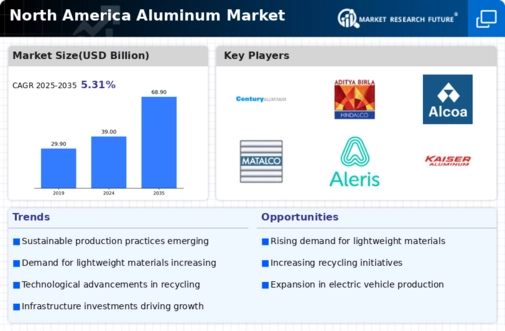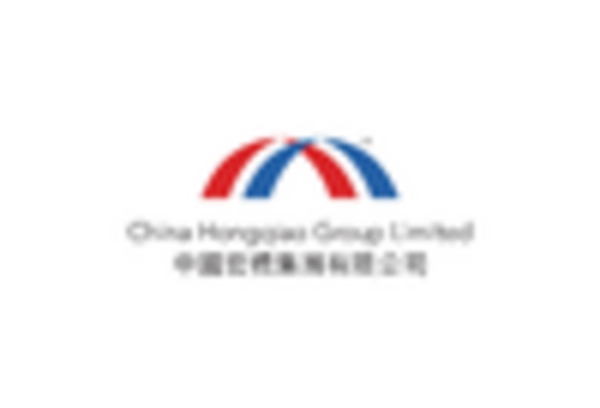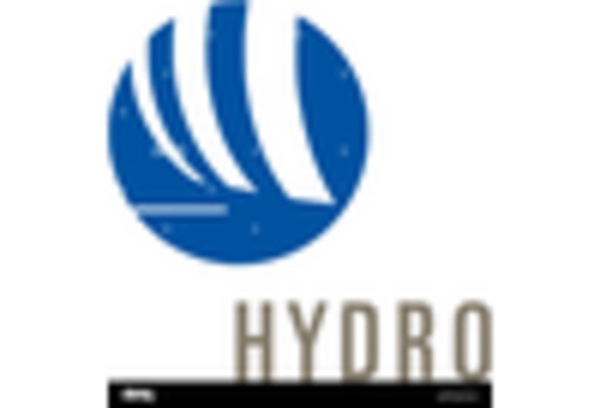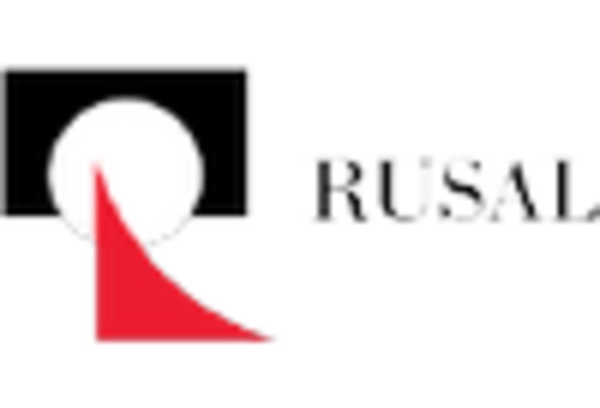Growth in Aerospace Applications
The aerospace sector in North America is increasingly adopting aluminum for aircraft manufacturing due to its lightweight properties and high strength. The aluminum market is poised to benefit from this trend, as the demand for aluminum in aerospace applications is projected to grow by 12% annually through 2025. This growth is driven by the need for fuel-efficient aircraft and the increasing production rates of commercial jets. Additionally, advancements in aluminum alloys are enhancing performance characteristics, making aluminum an even more attractive option for aerospace manufacturers. As airlines focus on reducing operational costs and improving sustainability, the aluminum market is likely to see a significant uptick in demand from this sector.
Rising Demand from Automotive Sector
The automotive sector in North America is experiencing a notable shift towards lightweight materials, with aluminum being a preferred choice due to its favorable strength-to-weight ratio. This trend is driven by the industry's focus on enhancing fuel efficiency and reducing emissions. In 2025, the demand for aluminum in automotive applications is projected to grow by approximately 15%, reflecting the increasing adoption of aluminum components in vehicle manufacturing. The aluminum market is likely to benefit from this surge, as automakers seek to comply with stringent environmental regulations while maintaining performance standards. Furthermore, the integration of aluminum in electric vehicles is expected to further bolster demand, as manufacturers aim to optimize battery efficiency and overall vehicle weight.
Infrastructure Development Initiatives
Infrastructure development in North America is witnessing a resurgence, with significant investments being made in transportation, utilities, and public works. The aluminum market stands to gain from this trend, as aluminum is extensively used in construction and infrastructure projects due to its durability and corrosion resistance. In 2025, it is estimated that the construction sector will account for nearly 30% of aluminum consumption in the region. Government initiatives aimed at modernizing infrastructure are likely to drive demand for aluminum products, including structural components and electrical wiring. This increased focus on infrastructure not only supports economic growth but also enhances the overall demand for aluminum, positioning the industry for sustained growth in the coming years.
Technological Innovations in Recycling
The aluminum market is increasingly influenced by advancements in recycling technologies, which enhance the efficiency and effectiveness of aluminum recovery processes. In North America, the recycling rate for aluminum is currently around 75%, and innovations in this area could potentially increase this figure further. The development of new methods for recycling scrap aluminum not only reduces production costs but also minimizes environmental impact, aligning with sustainability goals. As the industry moves towards a circular economy, the demand for recycled aluminum is expected to rise, with projections indicating a growth of 10% in recycled aluminum usage by 2026. This trend underscores the importance of recycling in the aluminum market, as it provides a sustainable source of raw materials.
Increasing Use in Renewable Energy Solutions
The aluminum market is experiencing a boost from the growing emphasis on renewable energy solutions in North America. Aluminum is a key material in the production of solar panels and wind turbines, both of which are integral to the transition towards sustainable energy sources. In 2025, the demand for aluminum in renewable energy applications is expected to rise by approximately 20%, driven by government incentives and private investments in clean energy projects. This trend not only supports the aluminum market but also aligns with broader environmental goals. As the push for renewable energy continues, the aluminum market is likely to see sustained growth, reflecting the material's versatility and essential role in modern energy solutions.

















Leave a Comment